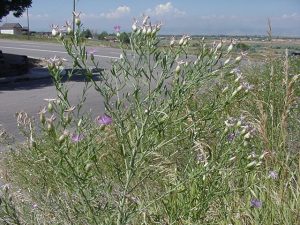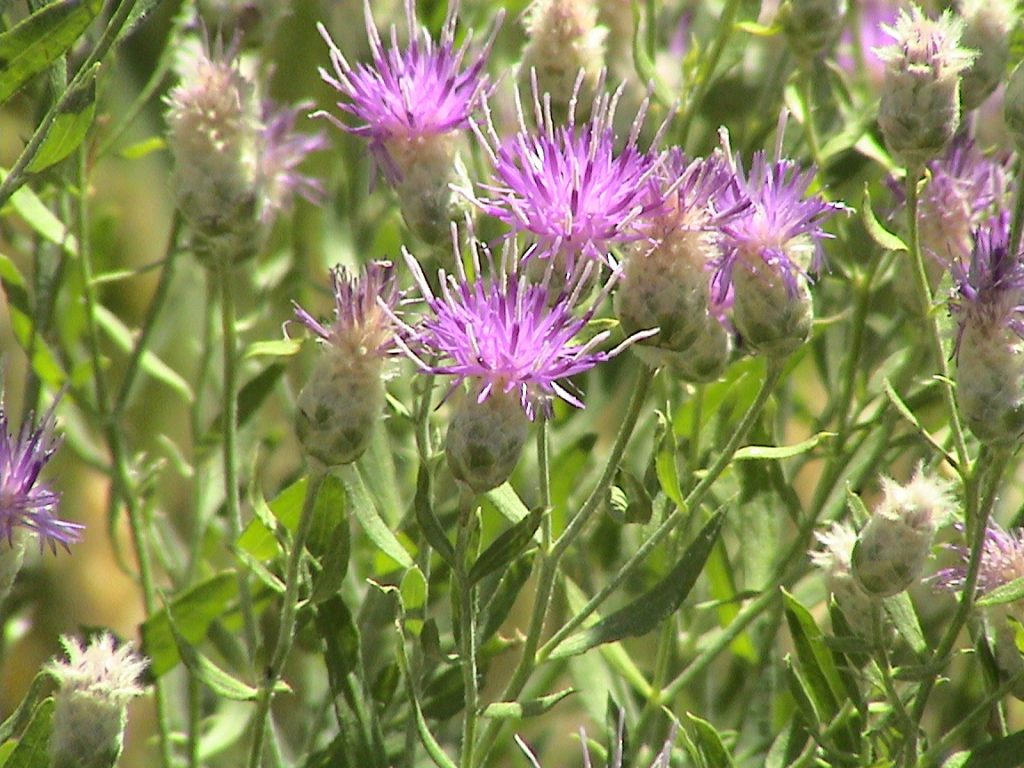Russian Knapweed (Acroptilon repens L.)
Identification
Russian knapweed is a native of Eurasia, probably introduced to North America about 1898. This plant is considered a noxious weed and is included on the Colorado and the Adams County Noxious Weed Lists. Russian knapweed is an aggressive perennial (lasts several years) weed that reproduces from seed and adventitious buds on a creeping root system.
This plant is allelopathic, which means it exudes toxins into the soil so that no other plant species can grow around it. Dense colonies are usually formed by the widely spreading black, bark-covered roots. Stems are covered with fine, white hairs that give the stem a blue-green color. Stems are erect, openly branched, with plants standing up to 3 feet tall. Flowers are pink to lavender in color, and are surrounded by pearly, rounded bracts with papery margins that are smooth to the touch.
Russian knapweed invades open, disturbed land, cultivated fields, along ditch banks, fence rows, roadsides, and in waste places. Once established, it tends to form a single-species stand and is very difficult to control or eradicate. Russian knapweed infestations reduce forage for livestock, and greatly reduce biodiversity for wildlife habitat. Plants ingested as fresh or dried forage are toxic to horses, causing a nervous disorder called “chewing disease”.
Approximately 1,400,000 acres in the western United States are infested. Roughly 30,000 of those acres are infested in Colorado.
Cultural Management
 Seeding and maintaining aggressive grasses such will help in competing with Russian knapweed and slow its spread. Proper fertilization, grazing, and supplemental irrigation of grasses are always effective cultural control methods.
Seeding and maintaining aggressive grasses such will help in competing with Russian knapweed and slow its spread. Proper fertilization, grazing, and supplemental irrigation of grasses are always effective cultural control methods.
Due to the allelopathic properties of this weed, supplemental control methods, such as judicious use of herbicides, may be needed to give grasses a chance to compete. Additional herbicide treatments after grass establishment may be needed to keep Russian knapweed populations reduced to an acceptable level.
More complete information on grasses can be found on the Grass Seeding on the Eastern Front-Range of Colorado page or by contacting the Natural Resources Conservation Service.
Mechanical Management
Mowing and other mechanical methods can be employed every 14 to 21 days to prevent seed set and to stress the plants. Whether these efforts will reduce root mass and plant stand is unknown. As a creeping perennial, Russian knapweed is difficult to control by hand-pulling or grubbing. Cultivation is marginally effective on crop lands.
Biological Management
No effective biological control agents are known currently for this weed. Horses cannot be allowed to graze this knapweed as they can develop chewing disease. A root nematode (Subanguina picridis) Has provided poor control.
Herbicide Management
A number of herbicides are labeled for use on Russian knapweed. Those that have been effective when used independently or in combination with each other are: chlorosulfuron (Telar), picloram (Tordon), 2,4-D, glyphosate (Roundup, Rodeo), dicamba (Veteran 10G), and Curtail. Refer to table below for more information.




